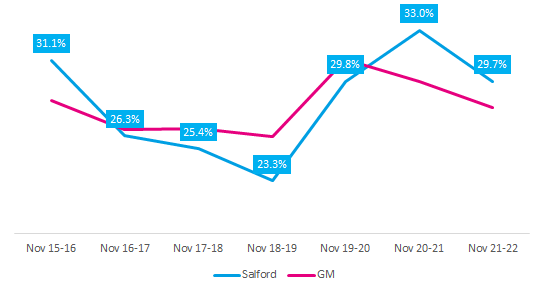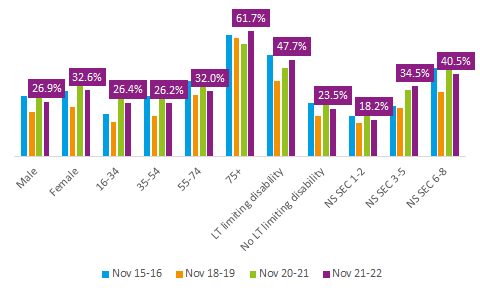Salford Adult Activity Levels 2021-22
Salford has recovered to baseline levels for both active (60.4%) and inactive (29.7%), but neither for pre-pandemic levels.
Salford Overview
Salford has recovered to baseline levels for both active (60.4%) and inactive (29.7%), but neither for pre-pandemic levels. Prior to the pandemic, Salford inactivity dropped below GM levels but has now increased above again.
Most demographics have seen a decrease in the last 12 months, except those aged 75+, NS SEC 3-5 groups and those with a long term health condition or disability (LTHC). These groups are all much more inactive in Salford compared to GM levels.
Those aged 16-34 years are more inactive than 35-54 years in Salford. Along with those aged 75+ and NS SEC 3-5 groups, these groups are the only ones not to have recovered to baseline.
Inactivity
The inactive population has seen a decrease in the last 12 months (-3.3%), is below baseline (-1.4%) but higher than pre-pandemic levels (+6.4%).

Differences across demographics
Most demographics have seen a decrease in the last 12 months, except those aged 75+, NS SEC 3-5 groups and those with a LTHC. These groups are all much more inactive in Salford compared to GM levels.
Those aged 16-34 years are more inactive than 35-54 years in Salford. Along with those aged 75+ and NS SEC 3-5 groups, these groups are the only ones not to have recovered to baseline. No groups have recovered to pre-pandemic levels.
The gap between males and females is higher than GM, with females inactivity being much higher whilst males inactivity being similar to GM.

If you have questions about this data please email: [email protected]
Published April 2023
